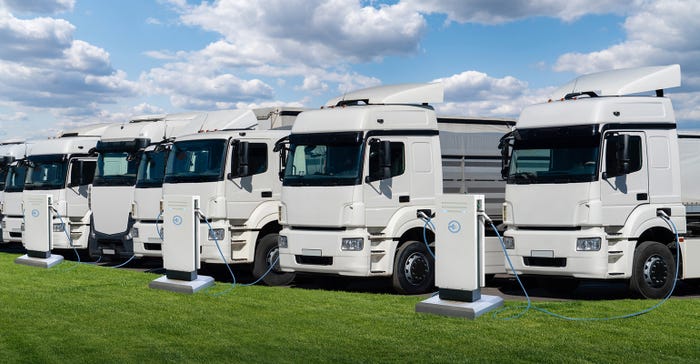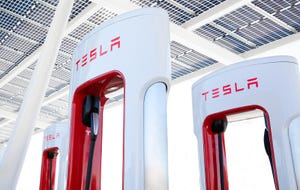Requirements for domestic content of battery minerals and components and California’s heavy-truck rule—half of them sold must be electric by 2035—challenge manufacturers.

On Friday, March 31, the Biden Administration made two major announcements designed to further spur the move to vehicle electrification and support the development of the manufacturing base needed to enable that move.
First, the US Treasury Department released proposed guidance on the new clean vehicle provisions of the Inflation Reduction Act (IRA). Its Notice of Proposed Rulemaking (NPRM) is meant to explain how manufacturers may satisfy the critical mineral and battery component requirements under the Inflation Reduction Act (IRA).
“Today, Treasury is taking an important step that will help consumers save up to $7,500 on a new clean vehicle and hundreds of dollars per year on gas, while creating American manufacturing jobs and strengthening our energy and national security,” stated Secretary of the Treasury Janet Yellen.
To be eligible for a $7,500 credit, clean vehicles must meet sourcing requirements for both the critical minerals and battery components contained in the vehicle. Vehicles that meet one of the two requirements are eligible for a $3,750 credit.
Critical mineral requirements
To meet the IRA-mandated critical mineral requirement and be eligible for a $3,750 credit, an annually increasing percentage of the critical minerals contained in the battery must be extracted or processed in the United States or a country with which the United States has a free trade agreement—or be recycled in North America:
For 2023, the applicable percentage is 40%.
For 2024, it moves up to 50%.
For 2025, it’s 60%.
For 2026, it’s 70%.
Beginning in 2027, it goes up to 80%.
The NPRM proposes a three-step process for determining the percentage of the value of the critical minerals in a battery that contribute toward meeting critical minerals requirement: 1.) determine procurement chains, 2.) identify qualifying critical minerals, and 3.) calculate qualifying critical mineral content.
The NPRM also details a proposed set of principles for identifying the set of countries with which the United States has a free trade agreement in effect, since this term is not defined in statute. Already included in the NPRM are: Australia, Bahrain, Canada, Chile, Colombia, Costa Rica, Dominican Republic, El Salvador, Guatemala, Honduras, Israel, Japan, Jordan, Korea, Mexico, Morocco, Nicaragua, Oman, Panama, Peru, and Singapore.
Battery component requirements
To meet the IRA-mandated battery component requirement and be eligible for a $3,750 credit, an annually increasing percentage of the value of the battery components must be manufactured or assembled in North America:
For 2023, the applicable percentage is 50%.
For 2024 and 2025, it’s 60%.
For 2026, it’s 70%.
For 2027, it’s 80%.
For 2028, it’s 90%.
Finally, beginning in 2029, it’s 100%.
The NPRM proposes a four-step process for determining the value: 1.) identify battery components that are manufactured or assembled in North America, 2.) determine the incremental value of each battery component, including North American battery components, 3.) determine the total incremental value of battery components, and 4.) calculate the qualifying battery component content by dividing the total incremental value of North American battery components by the total incremental value of all battery components.
The NPRM is filed for public inspection and will be published in the Federal Register on April 17, 2023. Vehicles placed-in-service on or after April 18, 2023 will be subject to the critical mineral and battery component requirements laid out in the rule. On that date, FuelEconomy.gov will contain a continually updating list of eligible clean vehicles that qualified manufacturers have indicated to the IRS meet the requirements to claim the new clean vehicle credit, including the amount of the credit.
EPA upholds California’s heavy-truck electrification requirement
That same day, the US Environmental Protection Agency (EPA) announced that it was granting to California the legal authority to require half of all heavy-duty trucks sold there be fully electric by 2035.

The EPA’s approval includes two other ACT regulations:
The Zero Emission Airport Shuttle Bus (ZEAS) Regulation, which establishes steadily increasing zero-emission airport shuttle fleet composition requirements for airport shuttle fleet owners who service the 13 largest California airports.
The Zero Emission Powertrain (ZEP) Certification Regulation, which establishes certification requirements and optional emission standards for 2021 and subsequent model year medium- and heavy-duty zero-emission vehicles (ZEVs) and the zero-emission powertrains installed in such vehicles.
“Under the Clean Air Act, California has longstanding authority to address pollution from cars and trucks. Today’s announcement allows the state to take additional steps in reducing their transportation emissions through these new regulatory actions,” stated EPA Administrator Michael S. Regan.
The EPA approval of California’s Advanced Clean Trucks (ACT) Regulation follows the state’s ban of the sale of new gasoline-powered cars, also beginning in 2035.
And where California, the most populous state in the US, goes, other states tend to follow.
CNBC points out that six other states have adopted the same heavy-truck regulations, “all of which were waiting for permission from the Biden administration to enact it.” The six states are Massachusetts, New York, New Jersey, Oregon, Vermont, and Washington. Others may be expected to follow suit.
CNBC also notes that some truck makers protest that meeting a percent-of-sales requirement for electric heavy-duty trucks will be expensive and hard to implement: "The Truck and Engine Manufacturers Association, an industry group that represents truck and bus manufacturers, has said that the standards would increase the cost of trucks and result in truck buyers delaying decisions to purchase new vehicles."
About the Author(s)
You May Also Like





